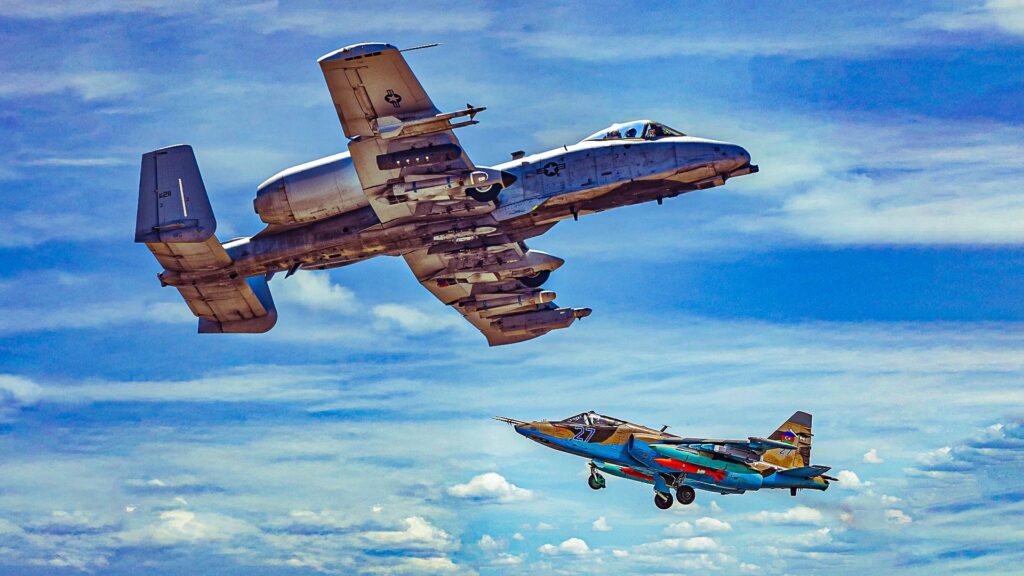
The A-10 Thunderbolt II, commonly known as the Warthog, is physically larger than the Sukhoi Su-25 Frogfoot. With a greater wingspan, length, and maximum takeoff weight, the A-10 commands a significant presence in the sky. While the Su-25 can weigh up to 38,800 lbs when fully loaded, the A-10 boasts a maximum takeoff weight of 51,000 lbs. This difference in size also translates to a larger payload capacity, positioning the A-10 as a formidable close air support aircraft.
Despite the Warthog’s advantages in size and payload, the Su-25 has its strengths. It reaches a peak speed of approximately 600 mph, outpacing the A-10’s maximum speed of 420 mph. The Su-25 is also equipped with more titanium armor, enhancing its durability. However, the A-10’s operating radius is significantly greater, allowing it to remain airborne longer and loiter over battlefields with ease.
Comparative Specifications
Both the A-10 and the Su-25 serve as dedicated close air support (CAS) aircraft, but they diverge in design and operational capabilities. Below is a side-by-side comparison based on data from the US Air Force and Air Force Technology:
| Specification | A-10 | Su-25 |
|---|---|---|
| Maker | Fairchild Republic Co. | Sukhoi |
| Power Plant | Two General Electric TF34-GE-100 turbofans | Two Soyuz / Gavrilov R-195s turbojet |
| Thrust | 9,065 lbs (40.32 kN) each | 9,929.97 lbs (44.18 kN) each |
| Length | 53 ft, 4 in (16.16 m) | 50 ft, 11 in (15.53 m) |
| Wingspan | 57 ft, 6 in (17.42 m) | 47 ft, 1 in (14.36 m) |
| Speed | 420 mph (675 km/h) | 602 mph (970 km/h) |
| Ceiling | 45,000 ft (13,636 m) | 22,965 ft (7,000 m) |
| Max Takeoff Weight | 51,000 lbs (22,950 kg) | 38,800 lbs (17,600 kg) |
| Range | 800 miles (695 nautical miles) | 405 nm (466 mi, 740 km) with full weapons load |
| Armament | One 30mm GAU-8/A Gatling gun; up to 16,000 lbs (7,200 kg) of mixed ordnance | One 30mm Gryazev-Shipunov GSh-30-2 autocannon; up to 9,700 lbs (4,400 kg) of missiles, bombs, or rockets |
The Su-25, while smaller and lighter, excels in maneuverability and can operate from shorter, less prepared airstrips. Its operational doctrine emphasizes speed and agility, enabling it to strike quickly in response to battlefield needs.
Operational Differences
The operational strategies of the Russian Air and Space Force and the US Air Force reveal how each aircraft fulfills its mission differently. The Su-25 is designed for rapid deployment near conflict zones, often utilizing austere airstrips to maximize its operational effectiveness. This approach allows Su-25 units to respond swiftly to air support requests from ground troops.
Conversely, the A-10, with its longer range, typically operates from established airbases. Its slower speed means it can loiter longer, providing sustained support over the battlefield. While both aircraft are effective in their roles, the A-10’s ability to carry a larger payload and maintain a presence in the air for extended periods often results in a quicker response to calls for assistance.
The A-10 has developed a loyal following among its pilots and support crews, despite facing calls for retirement over the years. As of 2025, the US Air Force plans to retire 56 A-10s this year, continuing a trend that will see the fleet fully decommissioned by 2029. The A-10 has survived many budget battles, yet it is now being replaced by advanced platforms like the F-15EX Eagle II and the F-35A Lightning II.
The Su-25 fleet, meanwhile, has faced challenges due to ongoing conflicts. Reports indicate that around 40 Su-25s have been lost since the onset of the Ukraine conflict in 2022, largely attributed to enhanced Ukrainian air defenses. The Russian military’s reliance on the Su-25 has been further complicated by sanctions impacting the country’s aerospace capabilities.
As the US military shifts its focus towards fifth-generation platforms that incorporate stealth technology and advanced sensor systems, the future of close air support remains uncertain. The evolution of warfare may see unmanned systems replace the aging A-10 and Su-25, leading to a potential decline in the traditional CAS aircraft class.
In summary, while the A-10 and Su-25 each have their unique strengths and weaknesses, they represent different philosophies in air support. The A-10’s endurance and payload capacity contrast with the Su-25’s speed and operational flexibility. As military strategies evolve, the role of these iconic aircraft faces significant transformation, raising questions about their future in modern warfare.







